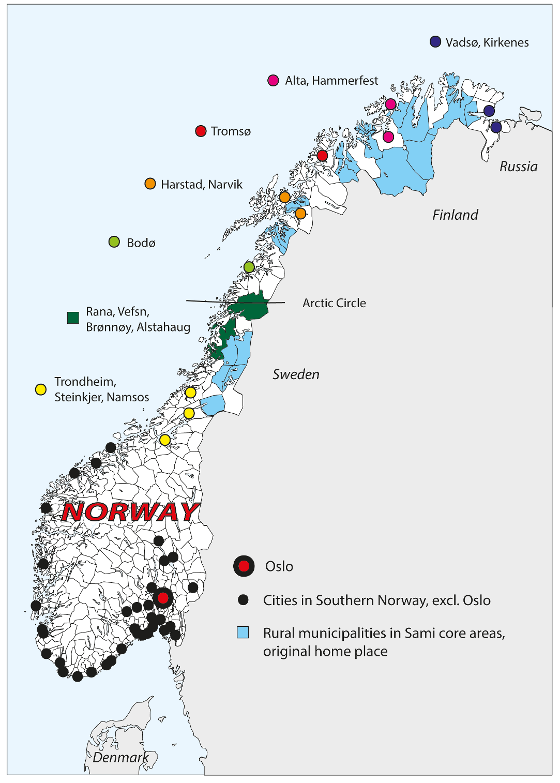From Rural to Urban Living: A study of health, living conditions and attachment
“From Rural to Urban Living” (in Norwegian: "Fra bydg til by") is a study based on a questionnaire survey from 2014. The aim is to enhance knowledge of health, culture and living conditions among Norwegian urban dwellers who originally come from rural areas with both Sami and Norwegian populations.
Background
Over the past 30 years, more and more people have been moving from rural to urban areas in Norway. The urban population is a very diverse group, as they have roots in different areas with various cultural backgrounds and life stories. Experiences, attitudes and values of people who have moved to urban areas will naturally be coloured by their family background and upbringing, in addition to other factors such as age, gender, education, occupation and income.
In order to improve knowledge of the health, culture and living conditions of urban dwellers who originally come from rural areas with Sami and Norwegian populations, the Centre for Sami Health Research (CSHR) initiated the study “From Rural to Urban Living”, in collaboration with the Norwegian Institute for Urban and Regional Research and the Sámi University of Applied Sciences in Kautokeino.
Design and method
The study consists of two stages:
Stage 1 was a registry analysis where we examined migration patterns through the first part of adulthood. We studied people born in 1950-74, dividing these 25 years into five age groups of five years each. Using the historical data of Statistics Norway, we selected all persons who lived in a Sami rural municipality at the age of 15. We then recorded where these people lived at the beginning of 2008, when they were aged 33-57 years. We explored whether they had lived in the same municipality all the time, had moved back after living somewhere else, had lived in different regions of Norway, and especially whether they had moved to an urban area and stayed there.
In Stage 2 a questionnaire was sent by post to people who had moved from the selected rural municipalities to urban areas and still lived there. Their children over the age of 18 were also sent a questionnaire. These data will form the basis for research on various areas of health and living conditions.

Geographical area
We invited all those people born in 1950-1975 who lived at the age of 15 in a rural municipality with both Sami and Norwegian populations, but at the time of the invitation lived in an urban area. The 23 rural municipalities selected were divided into seven regions.
- Inner Finnmark Karasjok and Kautokeino
- Eastern Finnmark Nesseby, Tana, Porsanger, Gamvik
- Western Finnmark Kvalsund, Loppa
- Northern Troms Kåfjord, Storfjord, Lyngen, Kvænangen
- Southern Troms Evenes, Skånland, Gratangen, Lavangen
- Northern Nordland Hamarøy, Tysfjord
- Southern Nordland/Namdalen Hattfjelldal, Grane, Namsskogan, Røyrvik, Snåsa
Fifty-one Norwegian towns and cities were included in the study; these are marked with dots in Figure 1:
Oslo, Bergen, Trondheim, Steinkjer, Namsos, Tromsø, Bodø, Vadsø, Kirkenes, Alta, Hammerfest, Harstad, Narvik, Rana, Vefsn, Brønnøy, Alstahaug, Sarpsborg, Fredrikstad, Halden, Moss, Drammen, Holmestrand, Horten, Tønsberg, Sandefjord, Larvik, Skien, Porsgrunn, Risør, Arendal, Grimstad, Kristiansand.
Aim of the study
The study examines migration patterns in Norway from multi-ethnic rural areas in the north to urban areas. In addition, the survey will provide new knowledge about health, culture and living conditions in a multi-ethnic population in Norwegian towns and cities, and the overall aim is to provide knowledge about health and living conditions in the Sami urban population.
“From Rural to Urban Living” includes four main topics:
1) Migration 2) Health and living conditions 3) Cultural and place attachment 4) Language
Findings from the registry study
A total of 22 997 people born between 1950 and 1974 lived in one of the 23 Sami municipalities at the age of 15. Of these, 8318, or about 36 percent, lived in an urban area in 2008. Thirty-nine percent of women and thirty-three percent of men had moved to a town or city.
The questionnaire survey
We invited all persons born between 1950 and 1975 who at the age of 15 lived in one of the 23 rural municipalities and in 2014 lived in one of the 51 cities. Their children over the age of 18 were also invited. Questionnaires were sent out to 6033 rural-to-urban migrants (first generation), 2058 (34 percent) of whom participated. In addition, 6197 children of the migrants (second generation) were invited, and 1168 (19 percent) of these participated. One in three participants reported Sami background. The questionnaire survey was conducted in March to October 2014. For further details, see an article that describes the sample and the data collection.
Further plans
This study gives a good picture of the migration pattern from selected rural municipalities in northern Norway. Further, the study will contribute research-based knowledge on health, living conditions and attachment in an urban population with roots in rural Northern Norway. Two research projects are currently using data from the questionnaire.
Publications
Broderstad AR, Broderstad EG. Flytting og urbanisering: Sapmi i forandring. I: Nystø SR, Guhttor M, Pedersen S, redaktører. Sametinget 25 år. Karasjok: Sametinget; 2014. s. 153-70. ISBN: 978-82-91200-19-4.
Melhus M, Eliassen BM, Broderstad AR. From Rural to Urban Living. A survey among internal migrants from Sami core areas to cities in Norway. Poster. Arctic Frontiers 2021.
Contacts
Principal investigator: Ann Ragnhild Broderstad
Data controller: The Director of UiT The Arctic University of Norway
Appendices
- Flytting til byer fra distriktsområder med samisk bosetting. Report (in Norwegian)
- Fra bygd til by spørreskjema, 1. generasjon (in Norwegian)
- Fra bygd til by spørreskjema, 2. generasjon (in Norwegian)
- Innkallingsbrev Fra bygd til by (in Norwegian)
- Fra bygd til by 1generasjon (questionnaire, English translation)
- Fra bygd til by 2generasjon engelsk oversettelse (questionnaire, English translation)